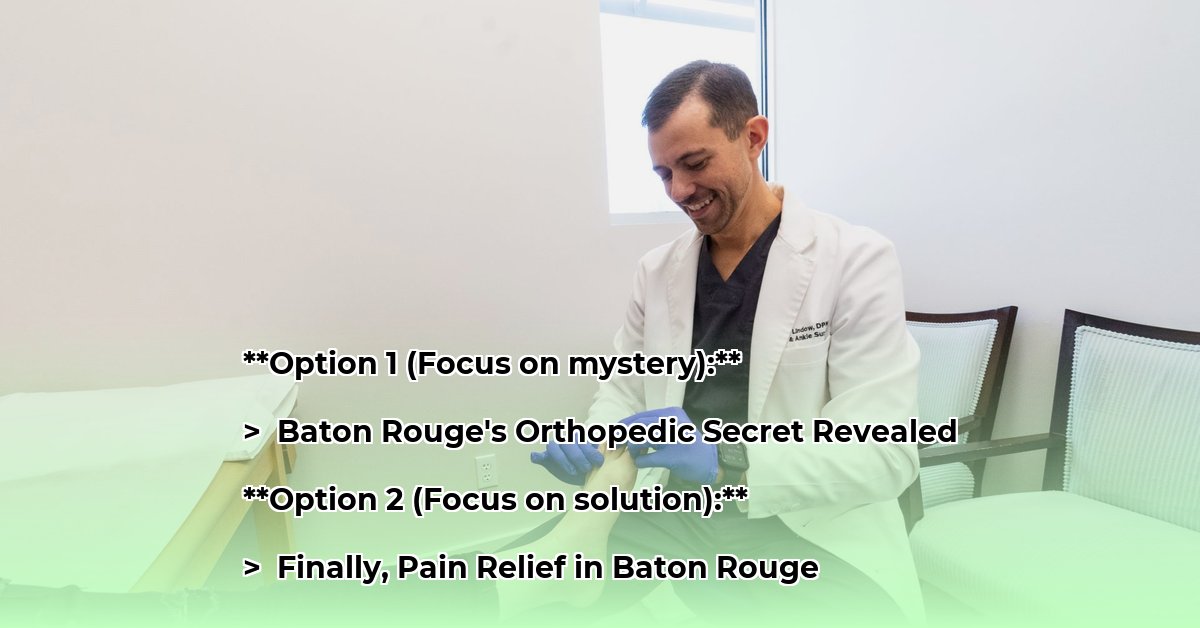
A High-Volume Orthopedic Surgeon in Baton Rouge
Dr. Kyle Girod, a board-certified orthopedic surgeon in Baton Rouge, Louisiana, maintains a high-volume practice specializing in spine surgery and nerve sheath tumor removal. His practice demonstrates significant experience in humerus fracture repairs and spinal osteoarthritis surgeries. However, understanding the implications of this high volume requires careful consideration. While high procedure numbers suggest extensive experience, they don't automatically equate to superior outcomes. Further investigation into patient outcome data is crucial for a comprehensive evaluation. This analysis will explore Dr. Girod's expertise, highlighting both strengths and limitations in available outcome information. For additional perspective on orthopedic practices, see this example.
Understanding Dr. Girod's Expertise and Practice
Dr. Girod's expertise extends beyond his high-volume procedures. He treats a diverse range of orthopedic conditions, including herniated discs, scoliosis, ankle fractures, and rheumatoid arthritis. This breadth of experience suggests adaptability in his approach to patient care. However, the high volume in specific procedures may indicate a particular area of focus and expertise. His fellowship training in adult and pediatric spine surgery further bolsters his credentials in this complex area. He employs both minimally invasive and traditional surgical techniques, tailoring his approach to individual patient needs. While minimally invasive techniques offer potential advantages, further research is needed to definitively compare their effectiveness to traditional methods across various conditions.
The Importance of Patient Outcome Data
A significant limitation in assessing Dr. Girod's practice is the lack of publicly available patient outcome data. This absence of readily accessible information about success rates, recovery times, and complication rates prevents a full evaluation of treatment effectiveness. This limitation is a hurdle for both prospective patients and referring physicians trying to make informed decisions. The need for greater transparency in this area remains a key concern.
Making Informed Decisions: A Practical Guide
The absence of readily available outcome data doesn't preclude informed decision-making. To help patients and referring physicians navigate this challenge, we've compiled actionable steps:
For Patients:
Seek Multiple Opinions: Obtain second and even third opinions from other qualified orthopedic surgeons, especially for complex procedures. This comprehensive approach ensures a thorough understanding of your condition and treatment options.
Review Online Resources Critically: While online reviews offer insights, remember they reflect only a fraction of patient experiences. Assess reviews with caution, understanding that they might not always represent the complete picture.
Engage in Direct Communication: Actively ask Dr. Girod (or any potential surgeon) direct questions regarding their approach, success rates (where available), and experience with similar cases. Open communication is key to informed choices.
For Referring Physicians:
Establish Consistent Referral Guidelines: Develop clear guidelines for patient referrals, accounting for condition type and complexity. This standardization ensures appropriate care regardless of the referring physician.
Request Outcome Data from Surgeons: Actively request patient outcome data whenever possible. This collaboration improves the overall understanding of treatment effectiveness.
Foster Collaboration and Information Sharing: Collaboration among medical professionals is essential. Sharing information on patient outcomes enhances treatment approaches and improves patient care.
For Improving Dr. Girod's Practice Transparency:
Implement Robust Outcome Tracking: Invest in a system to systematically collect and analyze patient outcome data. This is crucial for higher transparency and improved care quality.
Prioritize Data Transparency (Ethically): Proactively share relevant outcome data (while adhering to patient privacy regulations) with patients, referring physicians, and the broader medical community. Openness strengthens trust and confidence.
Maintain Ongoing Professional Development: Staying current on advancements in surgical techniques and outcome measures is crucial for maintaining high standards of care.
Navigating the Challenges: Looking Ahead
This analysis focuses solely on Dr. Girod's practice in Baton Rouge. The findings should not be generalized to other locations or surgeons. Further research is necessary to comprehensively understand his practice's outcomes and evaluate them against national averages and best practices. The dynamic nature of orthopedics necessitates continuous learning and data collection to stay at the forefront of patient care. The ultimate success of any medical practice depends on providing superior care and maintaining open communication with patients. While Dr. Girod's high procedure volume is notable, a more thorough understanding of patient outcomes is imperative for building trust and boosting the reputation of his practice. Continued efforts toward greater transparency significantly benefit patients, surgeons, and the broader medical community.
Key Takeaways:
- Dr. Girod demonstrates extensive experience in several orthopedic procedures, but lacks readily available patient outcome data.
- Patients and referring physicians should proactively seek multiple opinions and engage in open communication.
- Improved transparency in reporting patient outcome data is vital for enhancing patient care and building trust.
- The limitations of currently accessible outcome data emphasize the importance of independent verification and shared medical information in making informed decisions.